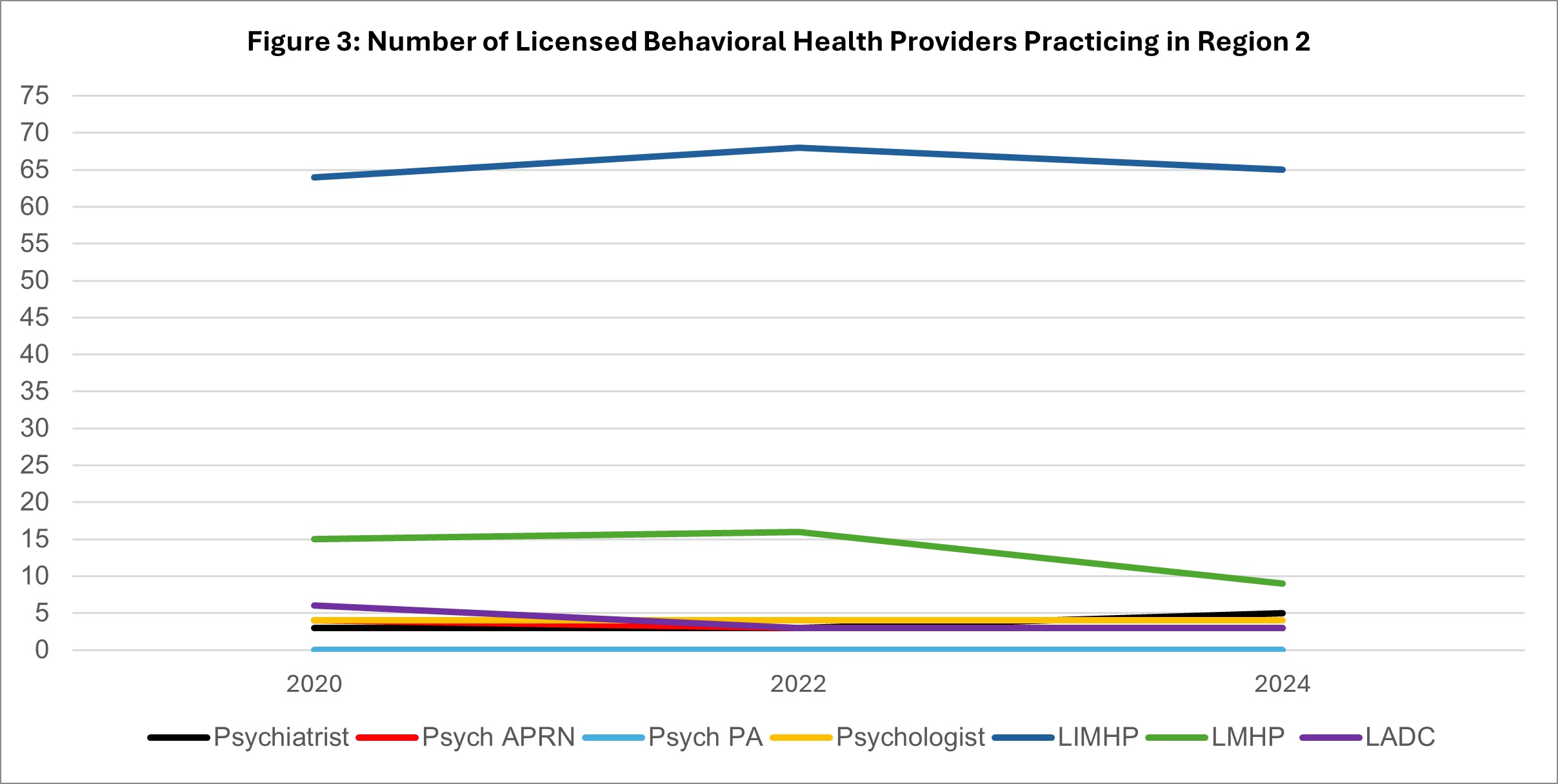Behavioral Health Providers Practicing In Nebraska Behavioral Health Regions: 2020 to 2024
Purpose
BHECN tracks behavioral health workforce trends for Psychiatrists, Psychiatric Advanced Practice Registered Nurses (APRNs), Psychiatric Physician Assistants (PAs), Psychologists, Licensed Independent Mental Health Practitioners (LIMHPs), Licensed Mental Health Practitioners (LMHPs) and Licensed Alcohol and Drug Counselors (LADCs) using data from the UNMC Health Professions Tracking Service.[1] This data snapshot presents information for each of the six Nebraska Department of Health and Human Services Behavioral Health Regions.[2],[3]Key Findings
- From 2020 to 2024, the total number of licensed behavioral health providers increased in four Regions (1, 4, 5, and 6) remained stable in Region 3, and decreased in Region 2.
- The total number of Psychiatrists, Psychiatric APRNs, and Psychiatric PAs increased in all regions.
- The total number of Psychologists, LIMHPs, LMHPs, and LADCs increased in four Regions (1, 4, 5, and 6), but decreased in two Regions (2 and 3).
- Regions with more rural counties, lower populations, and limited behavioral health training programs continue to have fewer providers and more providers nearing retirement age.
Comparison Across Behavioral Health Regions
From 2020 to 2024, the total number of licensed behavioral health providers increased in Region 1 (from 78 to 95), Region 4 (from 195 to 220), Region 5 (from 819 to 876), and Region 6 (from 1,633 to 1,779). The number of providers remained stable in Region 3 (324) and decreased in Region 2 (from 96 to 89). 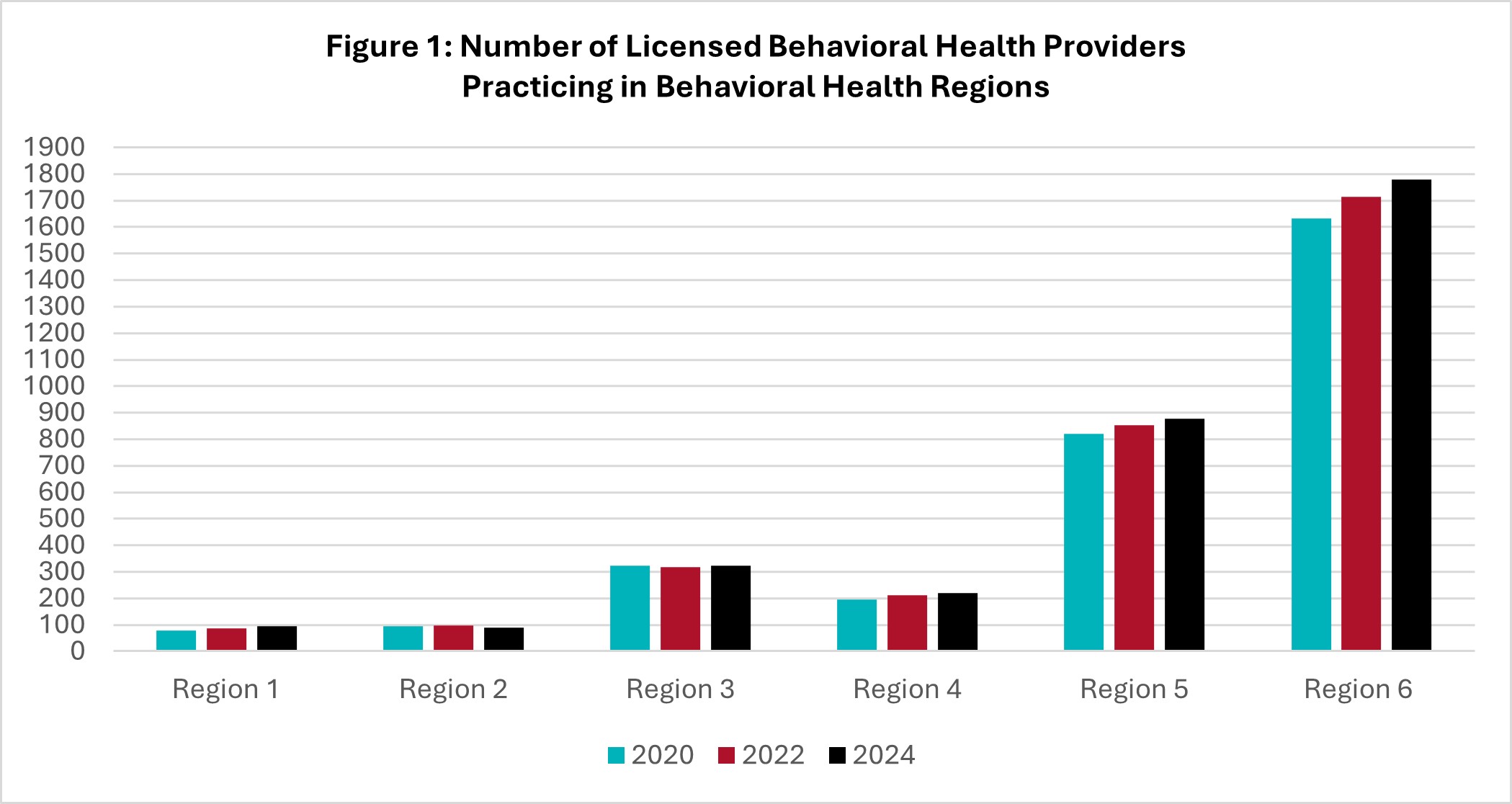
Region 1: The Panhandle
Population Size and Rurality
Over 82,000 residents live in Region 1, accounting for approximately 4% of Nebraska's population. The population in this region decreased 1.09% from 2020 to 2024.
All 11 counties in the region are rural.[4] Of the 11 counties, 7 have fewer than 5,000 residents, and 1 has fewer than 1,000. Three counties have no licensed behavioral health providers, though all neighbor a county that does.
Number of Licensed Behavioral Health Providers
In 2024, 3% of behavioral health providers had a primary office location in Region 1. The number of licensed behavioral health providers in Region 1 increased from 78 to 95 (22%) from 2020 to 2024. The number of all types of providers except LMHPs increased in Region 1 from 2020 to 2024 (see Figure 2). The decrease in the number of LMHPs is likely due to the conversion from LMHP to LIMHP license types.
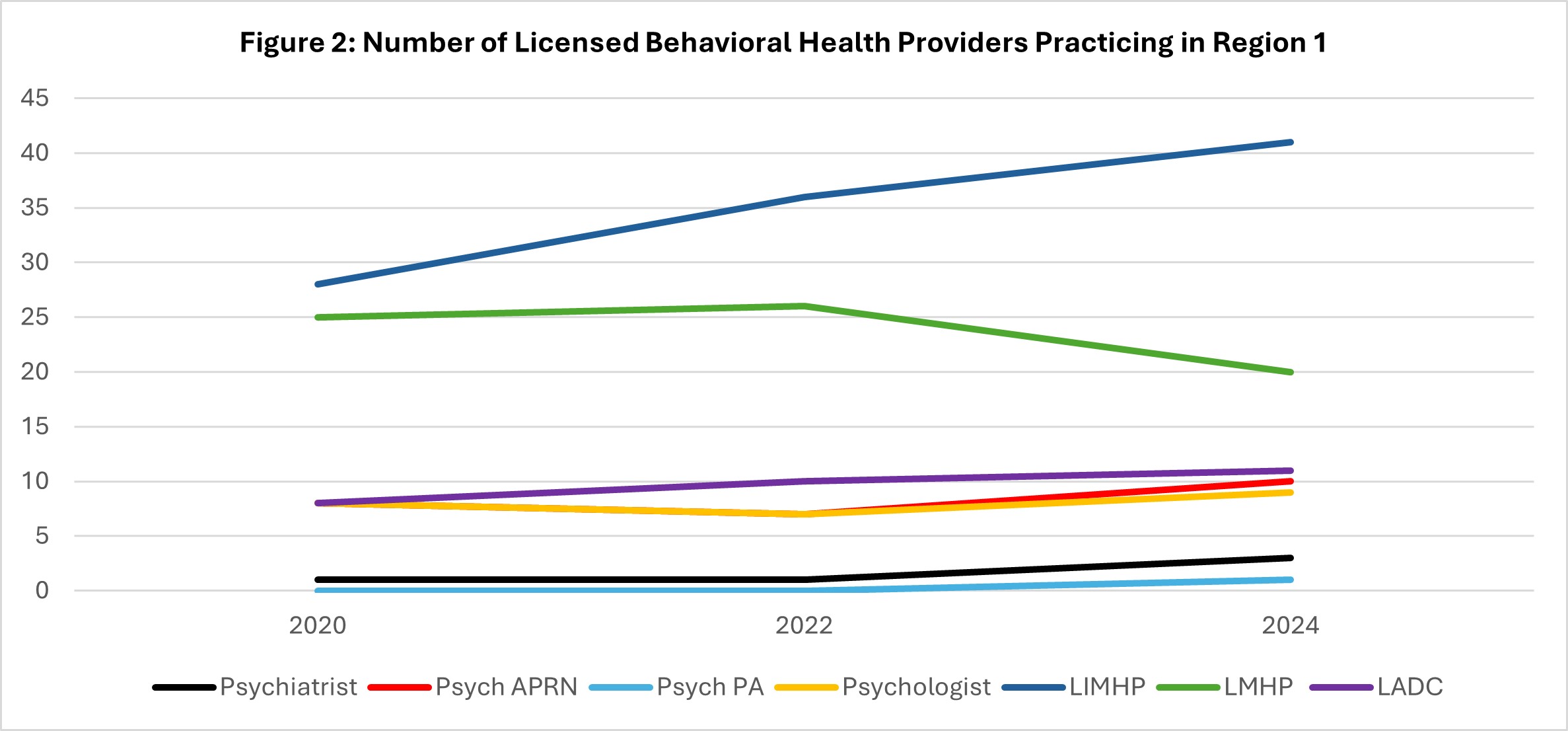
Behavioral Health Training Programs
No schools in Region 1 offer Psychiatry, Psychiatric PA, or graduate Psychology training programs. One school offers a Psychiatric APRN program, one offers a graduate Counseling program (leading to a LMHP license), and two offer LADC programs.
Percentage of Workforce Nearing Retirement Age
Forty percent of providers in Region 1 are aged 56 or older, which is higher than the average across Regions (37%).
Region 2: Southwest
Population Size and Rurality
Over 95,000 residents live in Region 2, accounting for approximately 5% of Nebraska's population. The population in Region 2 decreased by 1.89% from 2020 to 2024.
All 17 counties in the region are rural. Of the 17 counties, 13 have populations of less than 5,000, and 7 have populations of less than 1,000. Ten counties have no licensed behavioral health providers, including 3 (Grant, Hooker, and Thomas), where residents would likely need to drive more than an hour to access in-person behavioral health care.
Number of Licensed Behavioral Health Providers
In 2024, 3% of behavioral health providers had a primary office location in Region 2. The number of licensed behavioral health providers in Region 2 decreased from 96 to 89 (7%) between 2020 and 2024. The number of psychiatrists in Region 2 increased from 2020 to 2024, and the number of psychologists remained stable (see Figure 3). All other provider types decreased during this period. There are only five psychiatrists and three APRNs in all of Region 2, and all but one of these (an APRN) are in Lincoln County.
Behavioral Health Training Programs
No schools in Region 2 offer medical or graduate-level behavioral health education leading to behavioral health licenses.
Percentage of Workforce Nearing Retirement Age
Thirty-seven percent of providers in Region 2 are aged 56 or older, which is equivalent to the average across Regions.
Region 3: Central
Population Size and Rurality
Over 230,000 residents live in Region 3, accounting for approximately 12% of Nebraska's population. The population of Region 3 increased 0.52% from 2020 to 2024.
Nineteen of the 22 counties in this region are rural. Of the 22 counties, 18 have populations of less than 10,000, 12 have populations of less than 5,000, and 3 have populations of less than 1,000. Residents of 3 counties (Blaine, Loup, and Wheeler) would likely need to drive more than 30 minutes to access in-person behavioral health care.
Number of Licensed Behavioral Health Providers
In 2024, 10% of behavioral health providers had a primary office location in Region 3. The number of providers remained stable at 323 in Region 3 from 2020-2024. The number of Psychiatric APRNs and LIMHPs increased from 2020 to 2024 (see Figure 4). The number of Psychiatrists, Psychiatric PAs, Psychologists, and LMHPs decreased, whereas the number of LADCs remained stable.
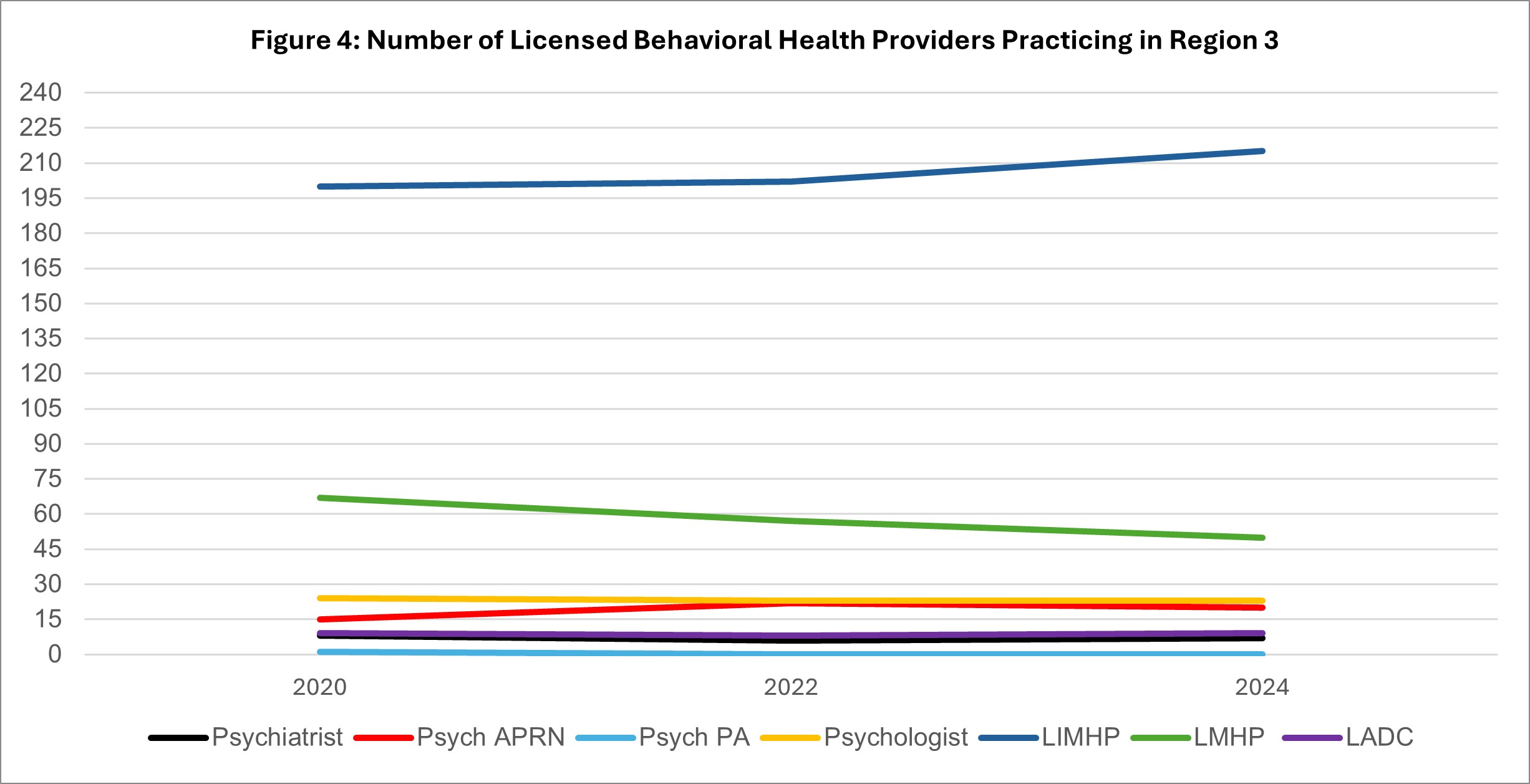
Behavioral Health Training Programs
No schools in Region 3 currently offer Psychiatry or graduate Psychology training programs. One school offers a Psychiatric APRN program, one offers a Psychiatric PA program, one offers a graduate Counseling program (leading to a LMHP license), and two offer LADC programs. Additionally, UNK, in partnership with UNMC, is constructing a Rural Health Education Building, which will house training programs for physicians as well as PAs, with anticipated completion in early 2026.
Percentage of Workforce Nearing Retirement Age
Thirty-nine percent of providers in Region 3 are aged 56 or older, which is slightly higher than the average across Regions (37%).
Region 4: North/Northeast
Population Size and Rurality
Over 205,000 residents live in Region 4, accounting for approximately 10% of Nebraska's population. The population of Region 4 increased 0.45% from 2020 to 2024. Twenty of the 22 counties in the region are rural.
Of the 22 counties, 17 have populations of less than 10,000, 5 have populations of less than 5,000, and 1 has a population of less than 1,000. Residents of four counties (Cherry, Boyd, Knox, and Cedar) would likely need to drive more than 30 minutes to access a Psychiatrist, Psychiatric APRN or PA within Nebraska.
Number of Licensed Behavioral Health Providers
In 2024, 7% of behavioral health providers had a primary office location in Region 4. The number of providers in Region 4 increased from 195 to 220 (13%) from 2020 to 2024. The number of Psychiatrists, Psychiatric APRNs, and LIMHPs in Region 4 increased from 2020 to 2024 (see Figure 5). The number of Psychologists, LMHPs, and LADCs decreased, whereas the number of Psychiatric PAs remained stable. Notably, the western half of Region 4 is significantly less populated and has considerably fewer licensed behavioral health providers (19 vs. 200), with only 2 Psychiatric APRNs and no Psychiatrists or Psychiatric PAs.
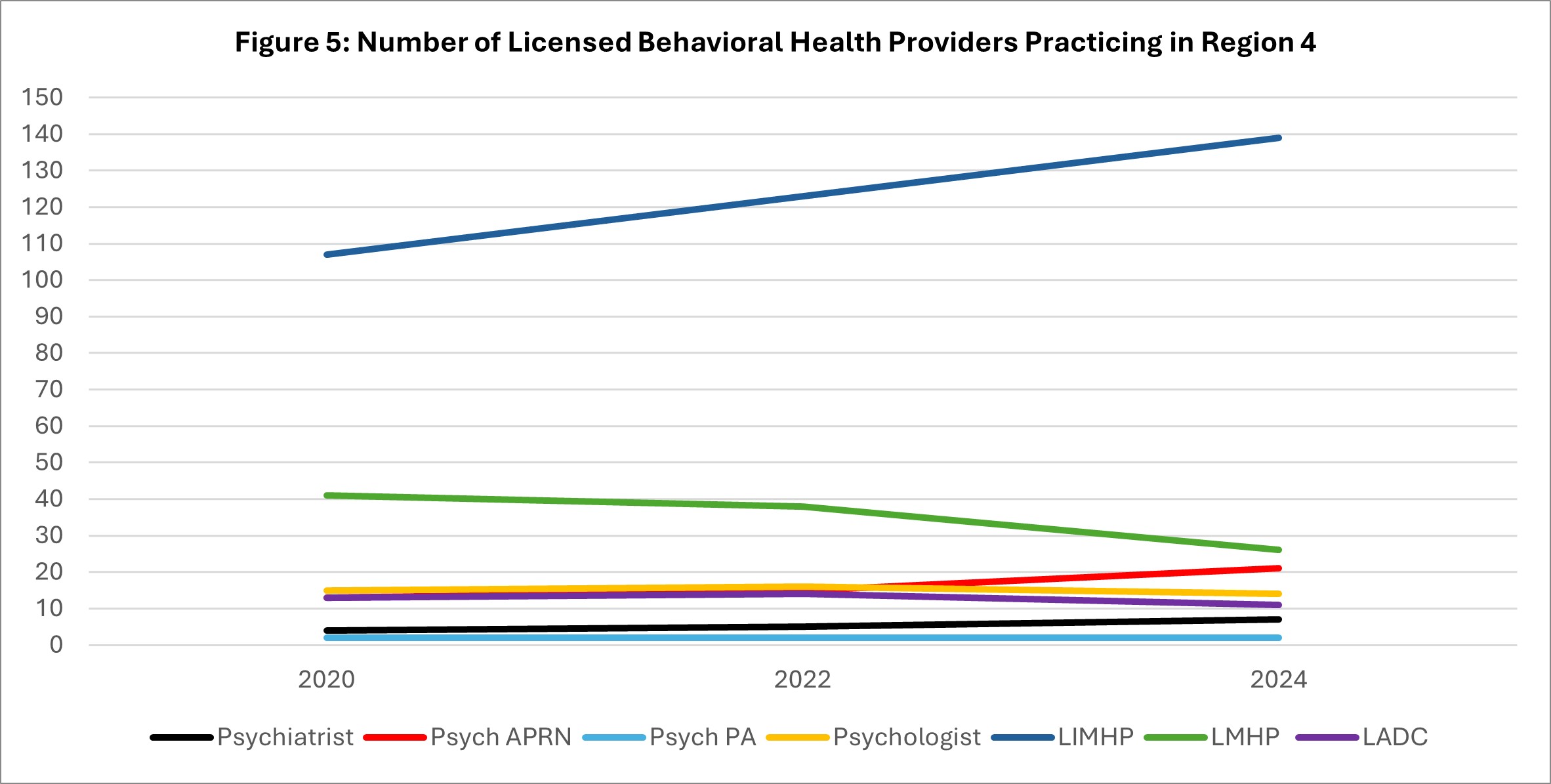
Behavioral Health Training Programs
No schools in Region 4 offer Psychiatry, Psychiatric PA, or graduate Psychology training programs. One school offers a Psychiatric APRN program, one offers a graduate Counseling program, and one offers an LADC program.
Percentage of Workforce Nearing Retirement Age
Thirty-nine percent of providers in Region 4 are aged 56 or older, which is slightly higher than the average across Regions (37%).
Region 5: Southeast
Population Size and Rurality
Over 485,000 residents live in Region 5, accounting for approximately 25% of Nebraska's population. The population of Region 5 increased by 2.35% from 2020 to 2024.
Thirteen of the 16 counties in the region are rural. Of the 16 counties, 9 have populations of less than 10,000, and 2 have populations of less than 5,000. Residents of two counties (Pawnee and Richardson) would likely need to drive more than 30 minutes to access a Psychiatrist, Psychiatric APRN or PA within Nebraska.
Number of Licensed Behavioral Health Providers
In 2024, 25% of behavioral health providers had a primary office location in Region 5. The number of providers increased from 819 to 876 (7%) between 2020 and 2024. The number of Psychiatrists, Psychiatric APRNs, Psychiatric PAs, and LIMHPs in Region 5 increased from 2020 to 2024 (see Figure 6). The number of Psychologists, LMHP, and LADC decreased.

Behavioral Health Training Programs
No schools in Region 5 offer a Psychiatry training program. One school offers a Psychiatric APRN program, one offers a Psychiatric PA program, one offers three graduate Psychology programs, and three offer LADC programs. Four schools offer graduate programs that lead to the LMHP license (i.e., Counseling, Social Work, and Marriage and Family Therapy programs).
Percentage of Workforce Nearing Retirement Age
Thirty-five percent of providers in Region 5 are aged 56 or older, which is slightly lower than the average across Regions (37%).
Region 6: Omaha area
Population Size and Rurality
Over 875,000 residents live in Region 6, accounting for approximately 44% of Nebraska's population. The population of Region 6 increased by 3.64% from 2020 to 2024.
One of the five counties in the region is a rural area. All five counties have populations greater than 20,000.
Number of Licensed Behavioral Health Providers
In 2024, 52% of behavioral health providers had a primary office location in Region 6. The number of providers in Region 6 increased from 1,633 to 1,779 (9%) from 2020 to 2024. The number of Psychiatrists, Psychiatric APRNs, Psychiatric PAs, and LIMHPs in Region 6 increased from 2020 to 2024 (see Figure 7). The number of Psychologists, LMHPs, and LADCs decreased.
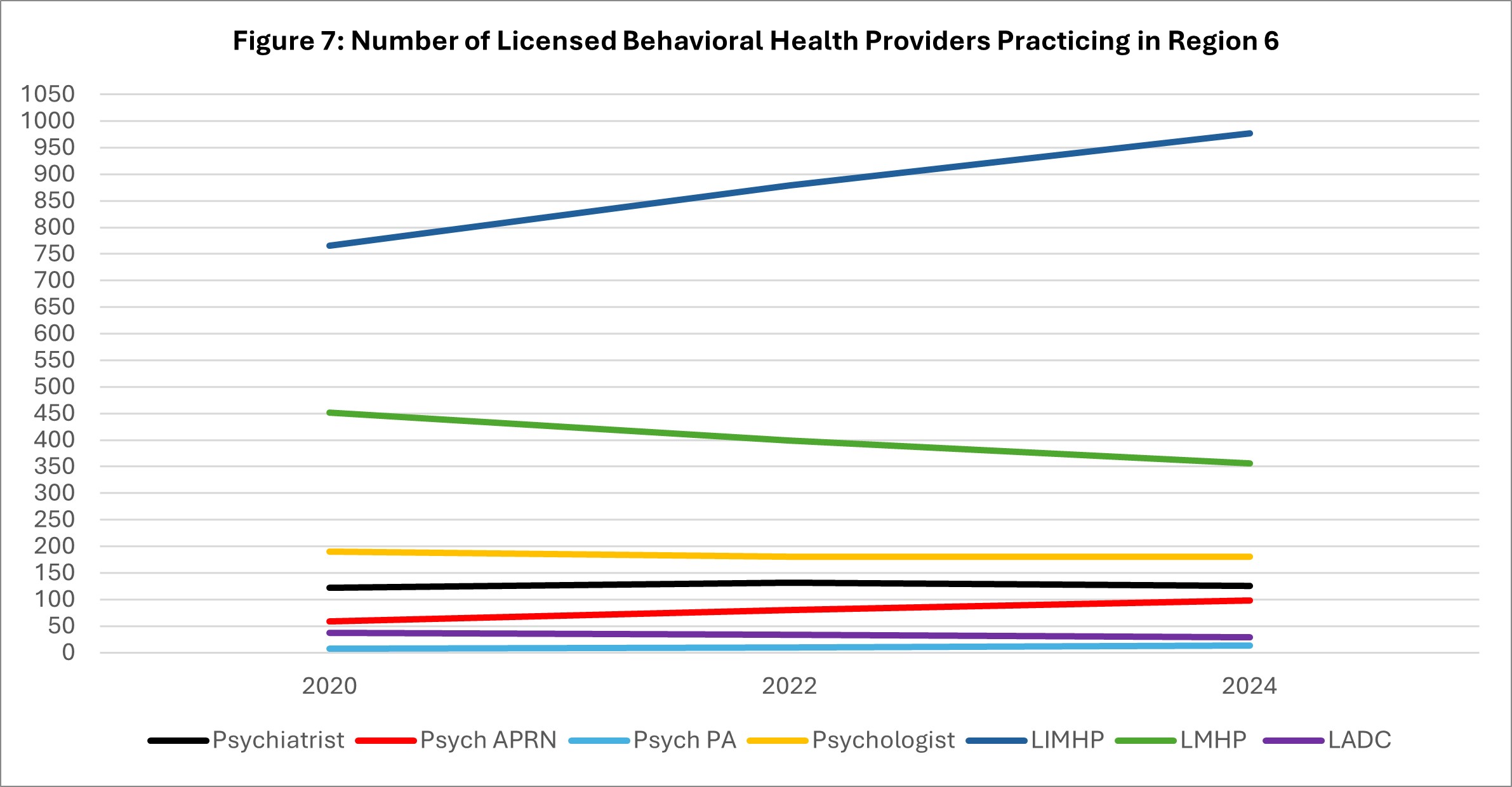
Behavioral Health Training Programs
Region 6 has two schools with Psychiatry residency programs, three schools with Psychiatric APRN programs, three schools with Psychiatric PA programs, one school with a graduate Psychology program, and two schools with LADC programs. Four schools offer graduate programs that lead to the LMHP license (i.e., Counseling and Social Work programs).
Percentage of Workforce Nearing Retirement Age
Thirty percent of providers in Region 6 are aged 56 or older, which is lower than the average across Regions (37%).
Suggested citation:
Behavioral Health Education Center of Nebraska. (2025). Behavioral Health Providers Practicing in Nebraska Behavioral Health Regions: 2020 to 2024.
https://www.unmc.edu/bhecn/research-data-policy/2020_2024_regional_snapshot.html
Footnotes
[1] We present hierarchical counts, where each licensed provider practicing in Nebraska is counted once, according to their highest license. Hierarchical counts allow us to examine changes in the total number of licensed behavioral health providers practicing in Nebraska. Given that LADCs also frequently hold a higher license, hierarchical counts may underestimate the number of LADCs.
[2] Nebraska Department of Health and Human Services. (2025). Behavioral Health Resources for Schools: Division of Behavioral Health. https://dhhs.ne.gov/BHSchoolResources/AboutDBH.pdf
[3] Additional information about each profession is available in the BHECN brochure Pathways to a Career in Behavioral Health. https://www.unmc.edu/bhecn/career-pathways/index.html
[4] Counties in Metropolitan Areas are considered urban and those in Micropolitan and Nonmetropolitan areas are considered rural, as per the Office of Management and Budget definitions.
